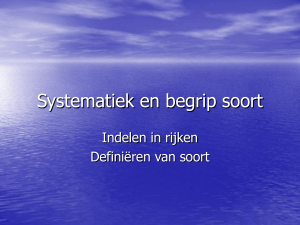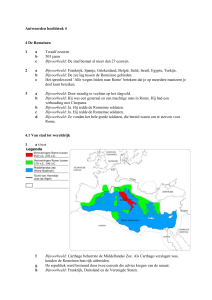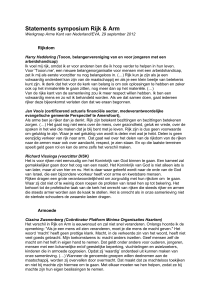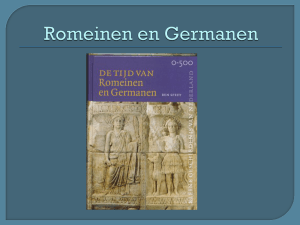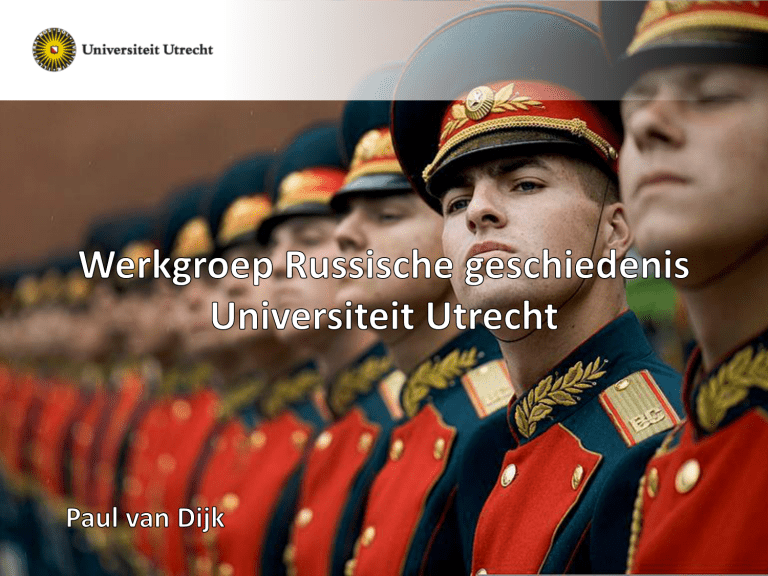
Rijken
Rijken
Verbeelding:
Imponerend
Van vroeger?
Verbeelding
Rijken
•
•
•
•
Kenmerken
Voorwaarden
Beschavingen
Rusland als rijk
Rijken
Wat is een rijk?
Kenmerken:
geografie
verovering
samengesteld
bestuurlijk gedifferentieerd
cultureel/etnisch divers
beheersing d.m.v. dwang
legitimatie: religieus
Rijken
Jane Burbank & Frederick Cooper, Empires in
World History: Power and the Politics of
Difference (Princeton & Oxford 2011):
‘Empires are large political units, expansionist or
with a memory of power extended over space,
polities that maintain distinction and hierarchy
as they incorporate new people.’
Rijken
Karen Barkey, Empire of difference. The
Ottomans in comparative perspective
(Cambridge 2008):
‘An empire is a large composite and
differentiated polity linked to a central power by
a variety of direct and indirect relations, where
the centre exercises political control through
hierarchical and quasi-monopolistic relations
over groups ethnically different from itself.’
Rijken
Stephen Howe, Empire. A very short introduction
(Oxford 2002):
‘An empire is a large, composite, multi-ethnic or
multinational political unit, usually created by
conquest, and divided between a dominant
centre and subordinate, sometimes far distant,
peripheries.’
Rijken
Charles Steinwedel, Threads of Empire. Loyalty
and Tsarist Authority in Bashkiria, 1552-1917
(Bloomington & Indianapolis 2016):
‘An imperial formation is a solution to a
particular set of challenges or goals. For most of
the Russian Empire’s history, the challenge of
empire was to maintain order and economic
production necessary to support tsarist rule
over a vast space with a diverse population.’
Typen rijk
Welke typen rijken zijn er?
Land- en zeerijken
Voorwaarden
Welke voorwaarden voor ontstaan van rijk?
Bevolkingsgroei
Efficiënte landbouw
Bescherming en beheersing
Systeem van herverdeling
Communicatie
Beschaving?
Wat is een beschaving?
‘Great tradition’ (Robert Redfield) & ‘little
tradition’
Belang van schrift
Communicatie op afstand, belastingen,
orthodoxe geschriften, schriftrituelen
Schrijver in Mogol India, c.
1625
Natiestaten
Staten
• Complexe samenlevingen
• Concentratie van de macht
• Efficiëntie
• Bureaucratie
• Interventie; sterke relatie staat-burger
• Publieke opinie
• Legitimatie: nationalisme
Natiestaten
Naties
• Modern
• Constructies
• Civiel/etnisch
Rusland als rijk
Russische rijk
Sovjet-Unie
Russische federatie
Waar kijk je naar?
Verschillen?
Soevereiniteit
Titel van Nicolaas II, volgens artikel 59 van de grondwet van 23 april
1906:
We, Nicholas II by the Grace of God, Emperor and Autocrat of all the
Russias, of Moscow, Kiev, Vladimir, Novgorod, Tsar of Kazan, Tsar of
Astrakhan, Tsar of Poland, Tsar of Siberia, Tsar of Tauric Chersonesos,
Tsar of Georgia, Lord of Pskov, and Grand Duke of Smolensk, Lithuania,
Volhynia, Podolia, and Finland, Prince of Estonia, Livonia, Courland and
Semigalia, Samogitia, Belostok, Karelia, Tver, Yugra, Perm, Vyatka,
Bulgaria and other territories; Lord and Grand Duke of Nizhni
Novgorod, Sovereign of Chernigov, Ryazan, Polotsk, Rostov, Yaroslavl,
Beloozero, Udoria, Obdoria, Kondia, Vitebsk, Mstislavl, and all northern
territories; Sovereign of Iberia, Kartalinia, and the Kabardinian lands
and Armenian territories - hereditary Lord and Ruler of the Circassians
and Mountain Princes and others; Lord of Turkestan, Heir of Norway,
Duke of Schleswig-Holstein, Stormarn, Dithmarschen, Oldenburg, and
so forth, and so forth, and so forth.
Soevereiniteit
Beheersing
Verder: strategieën van beheersing en rituelen.
Hoe ging het Russische rijk om met
verschillende, nieuwe elementen in het rijk en
hoe veranderde dat? Waarom paste het
centrum strategieën aan en waarom op die
manier? Welke symbolische
vormen nam dit aan?
Franz Moritz Brückner, Gefecht von
Baschkiren und Kosaken gegen
französische Infanterie 1813 (c.
1840).
С Новым годом!


